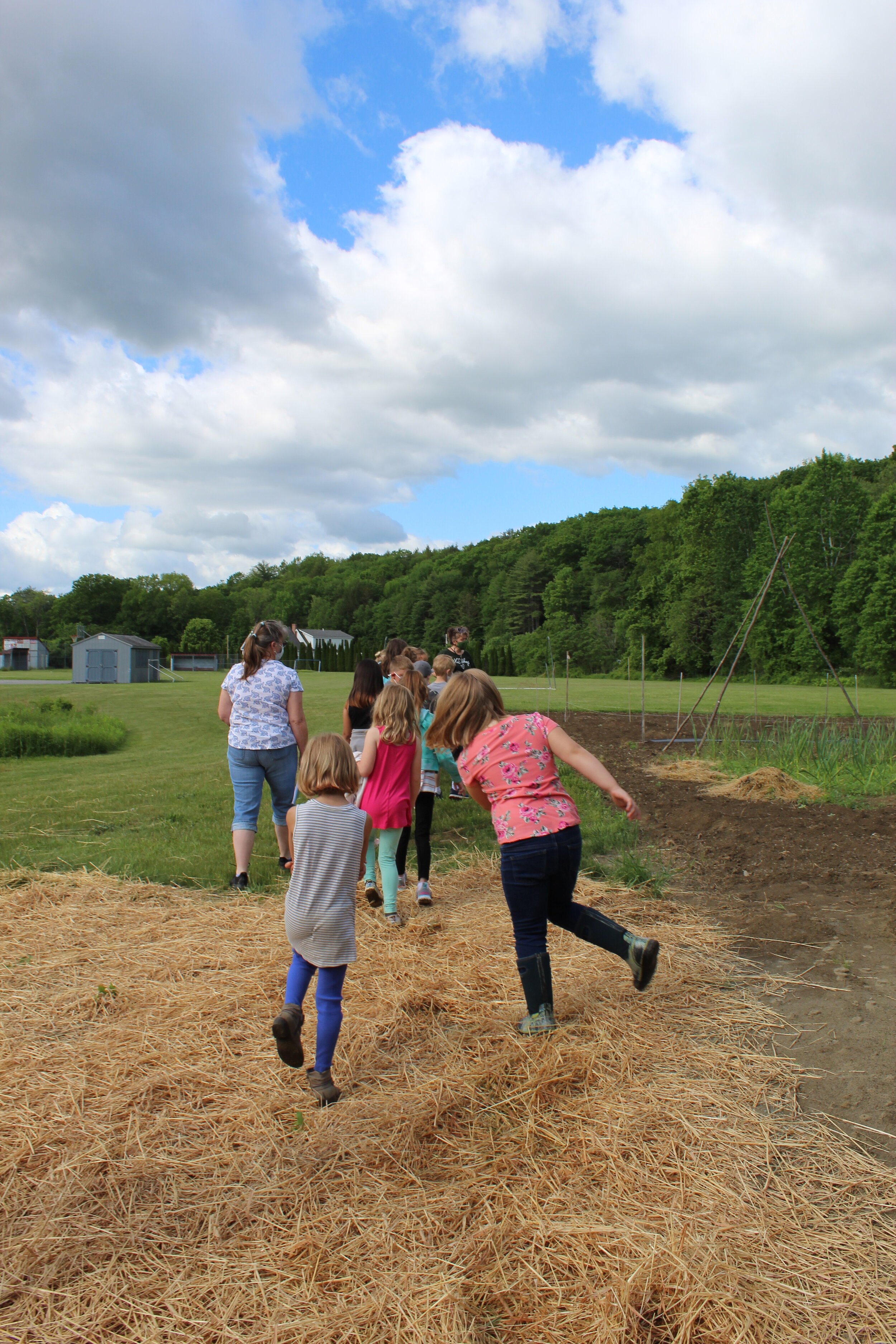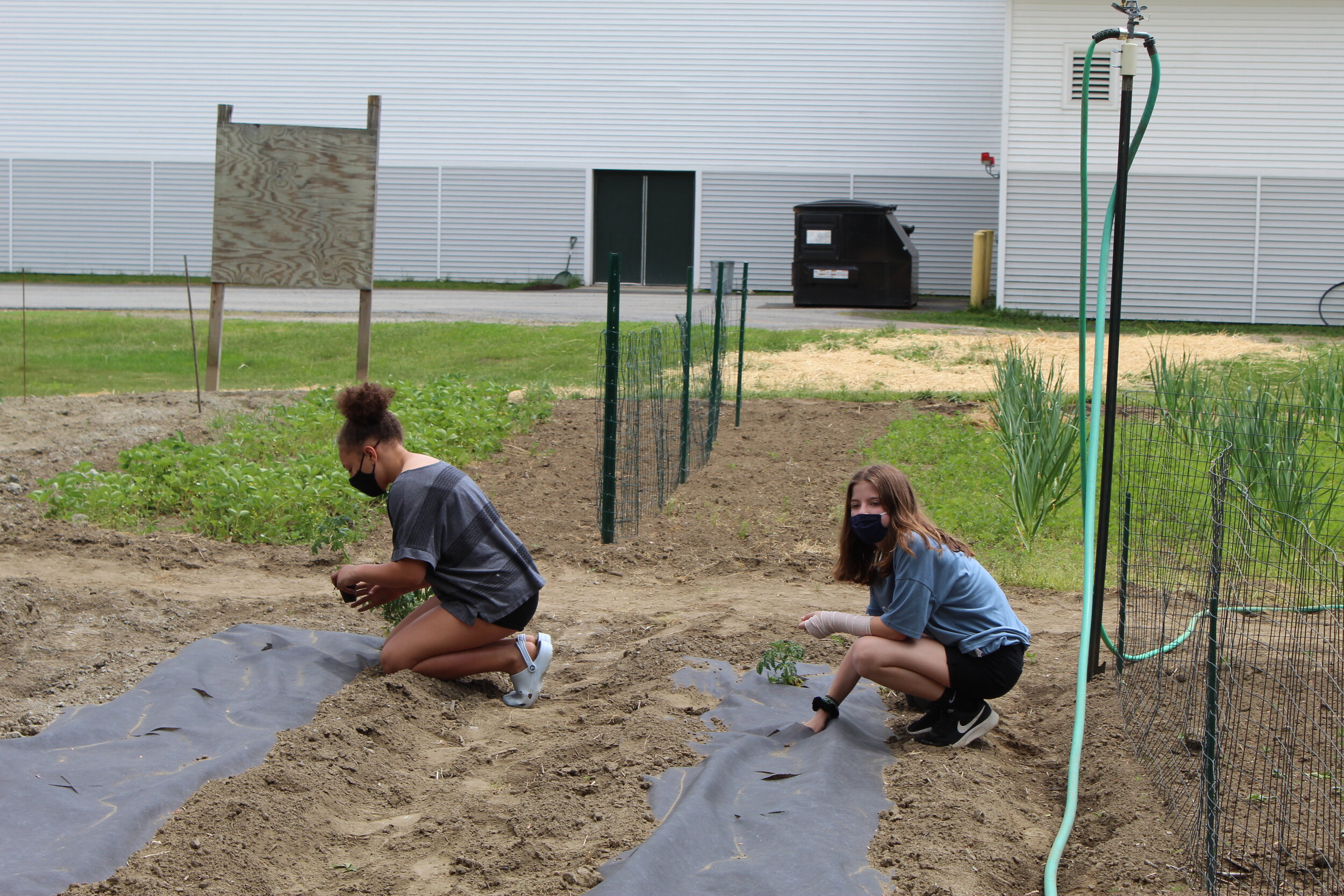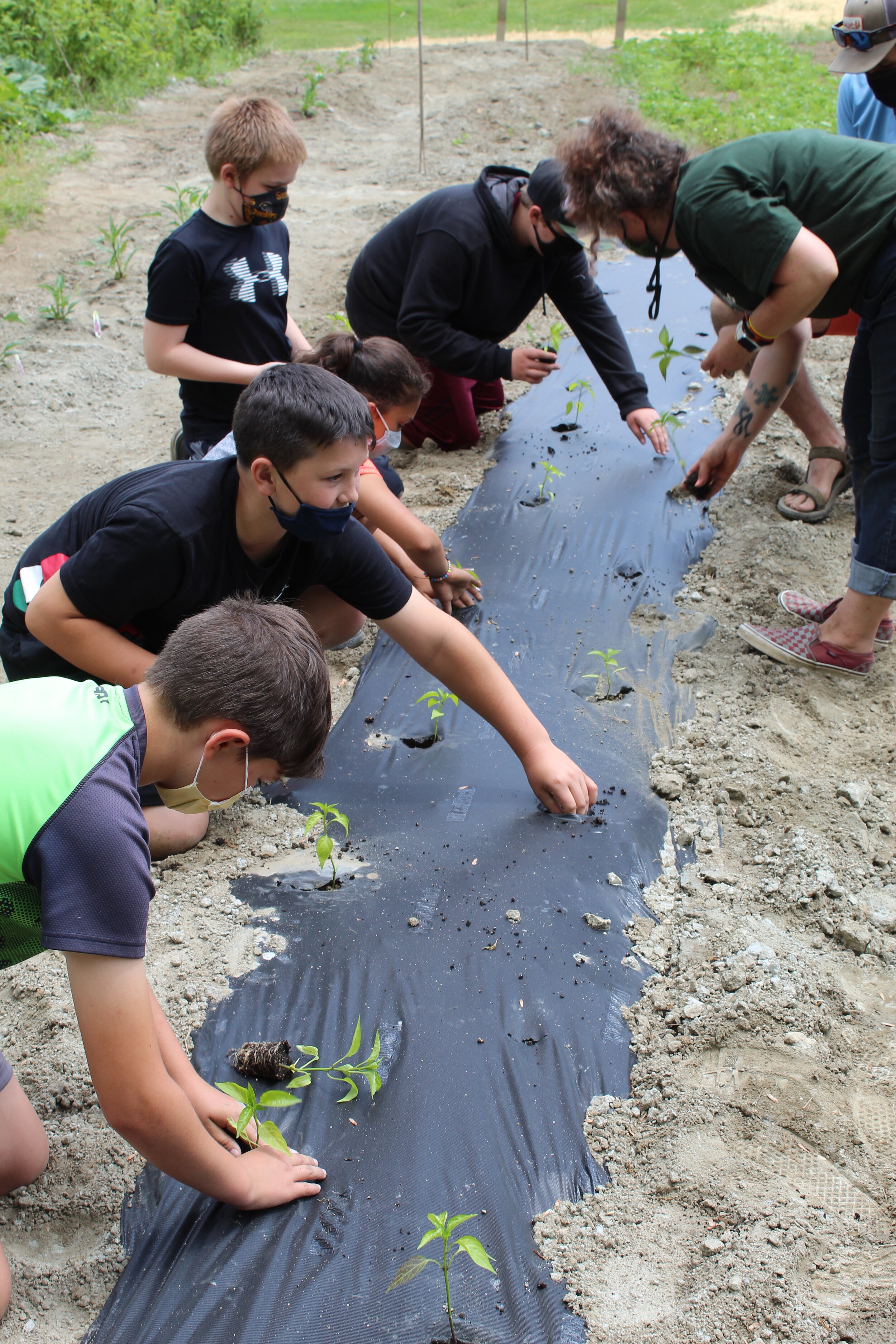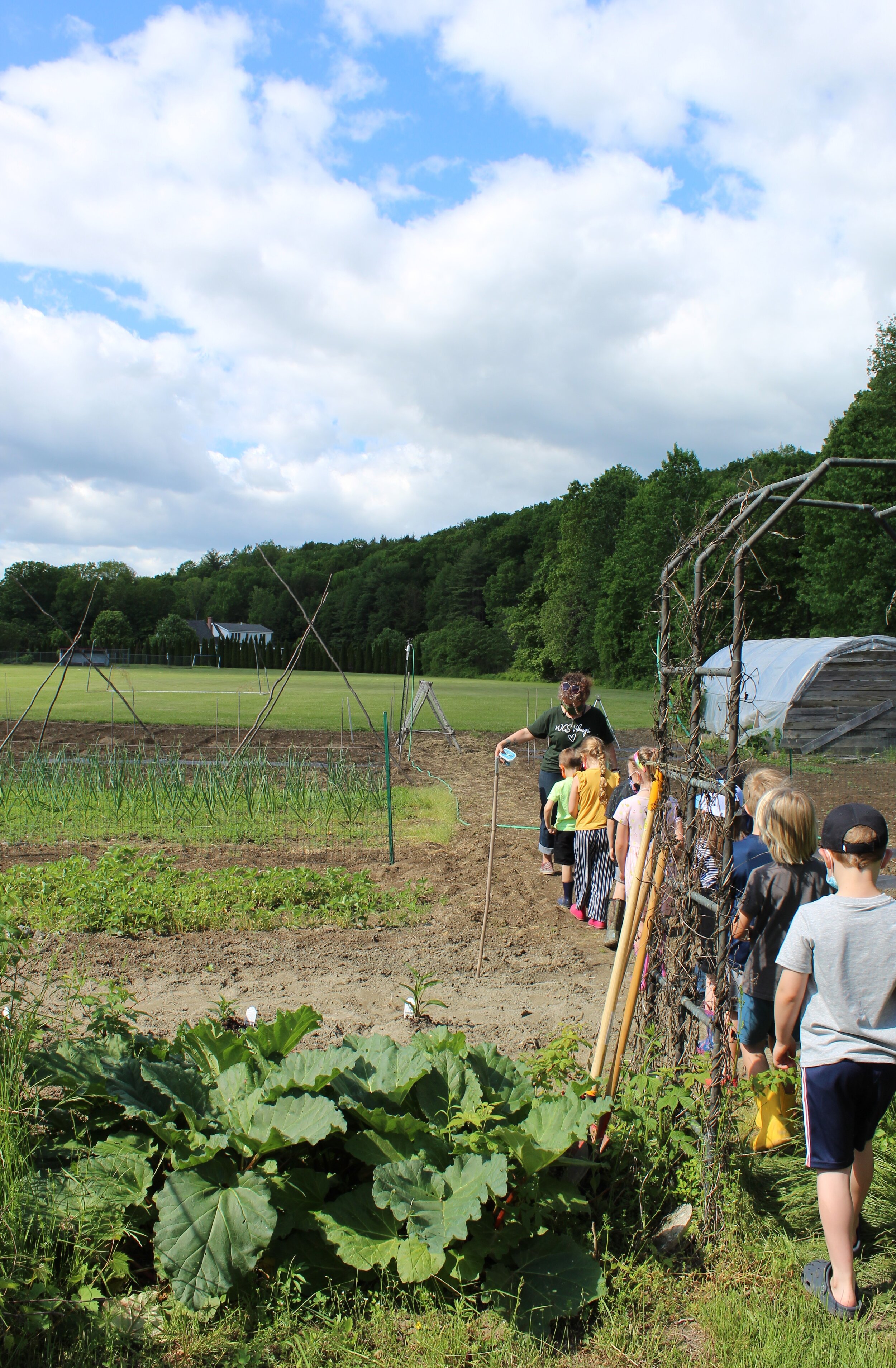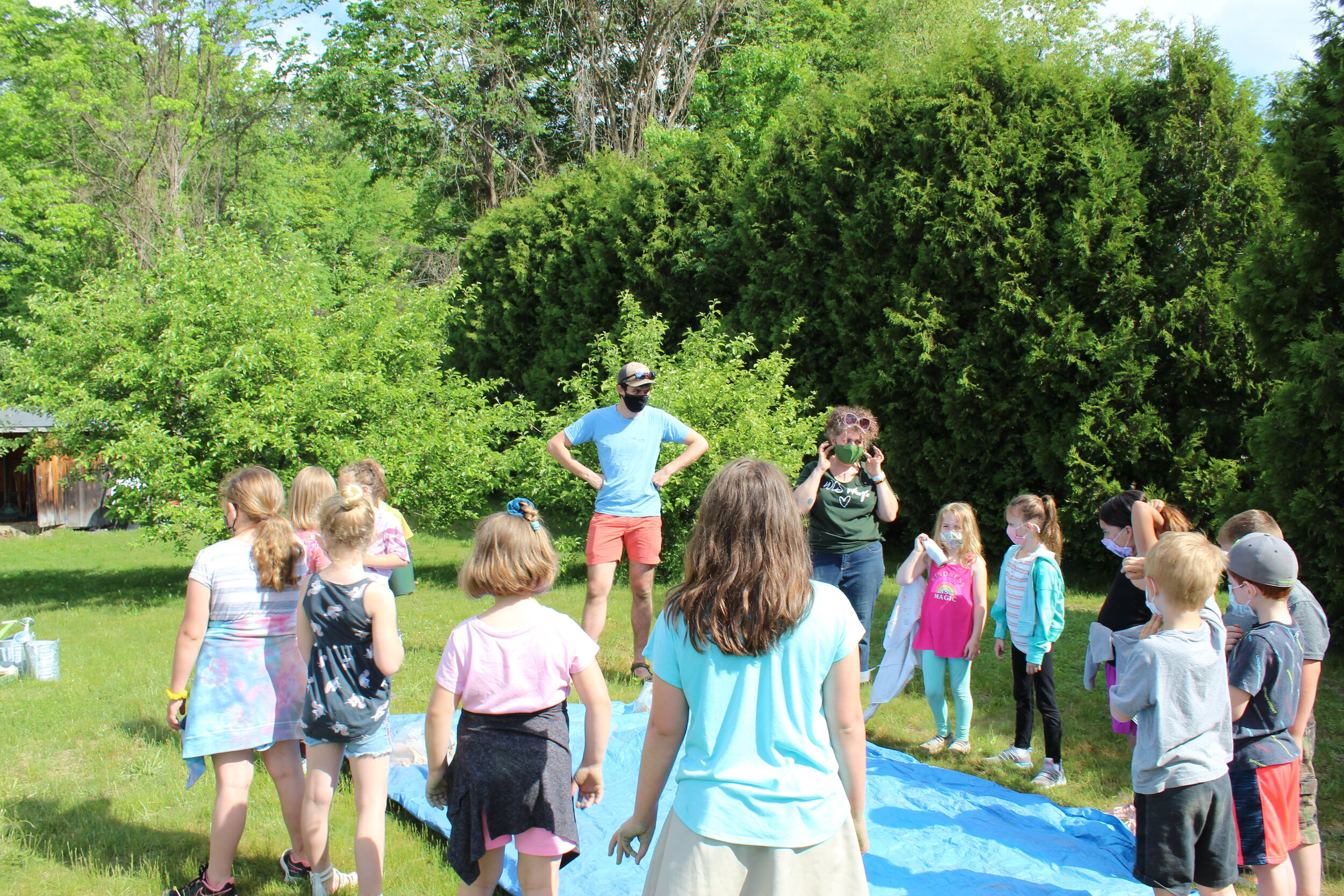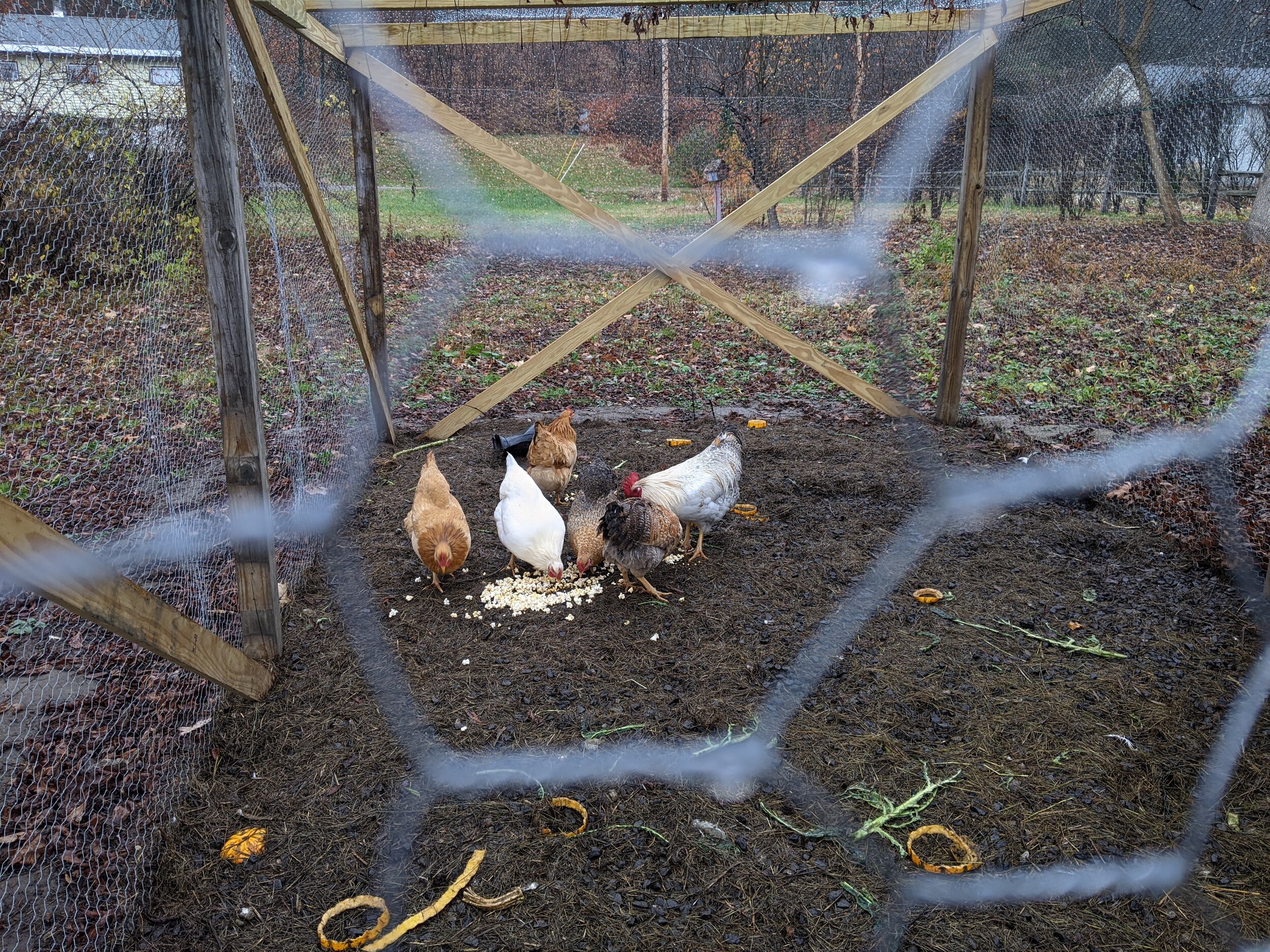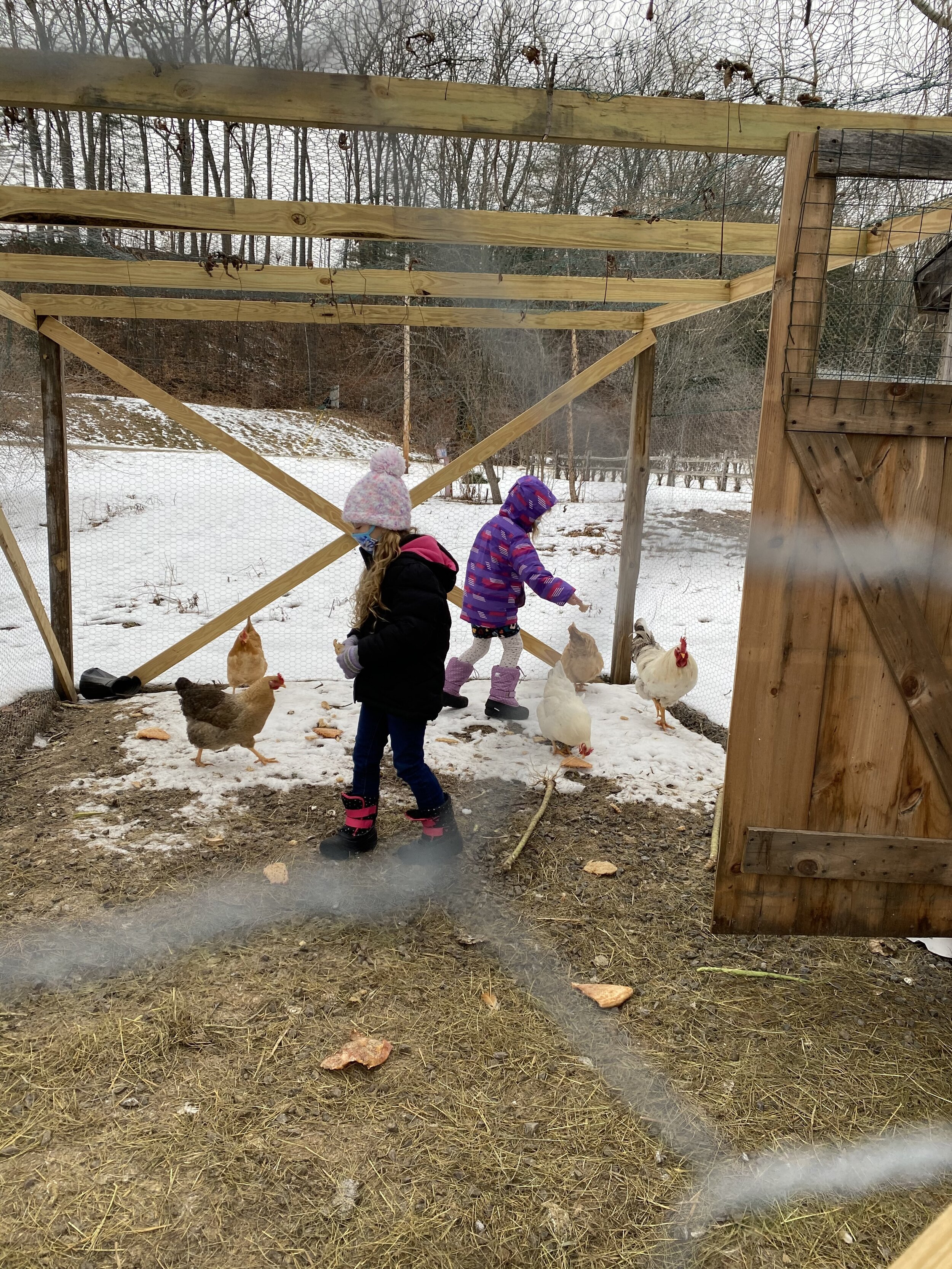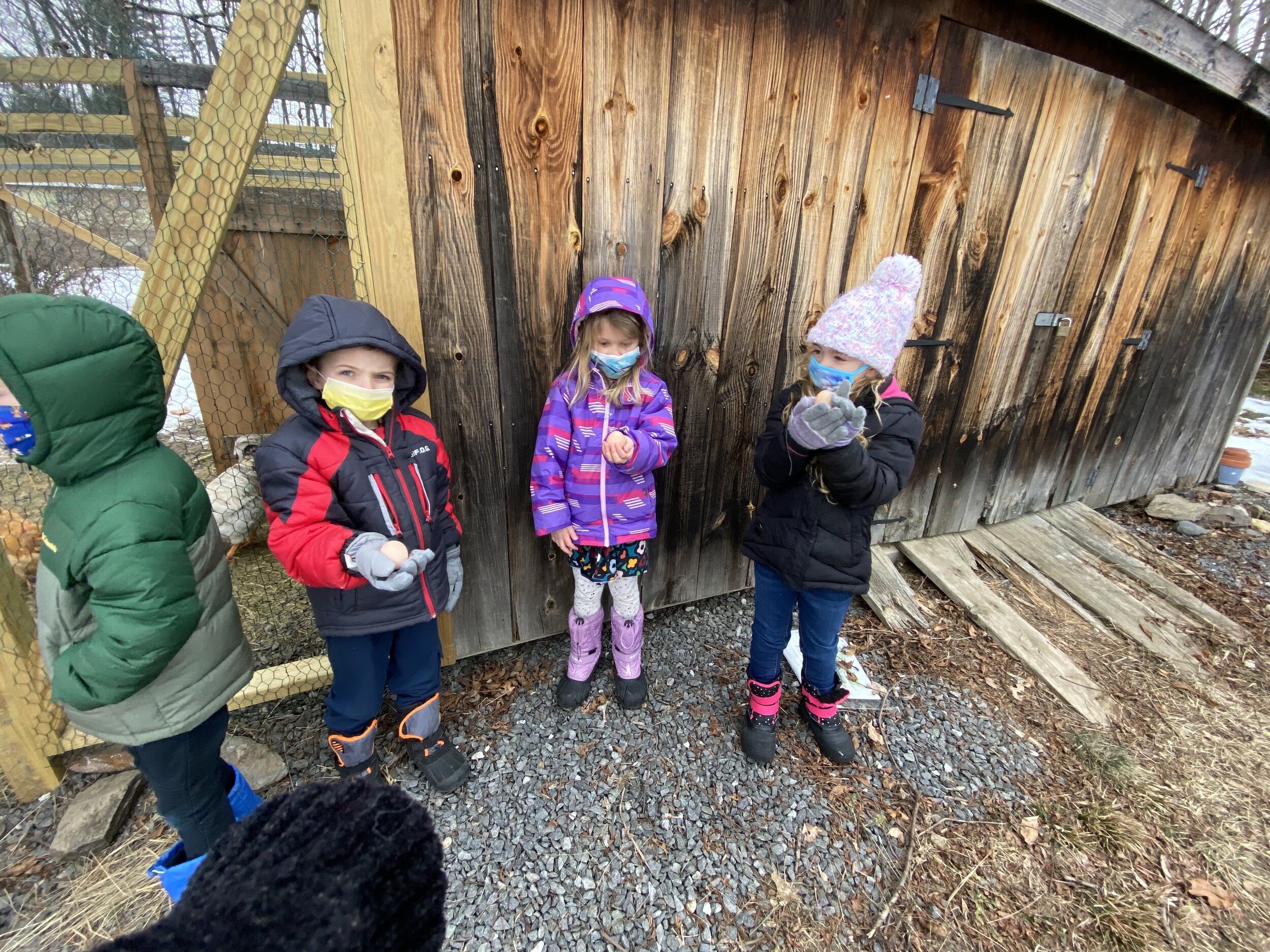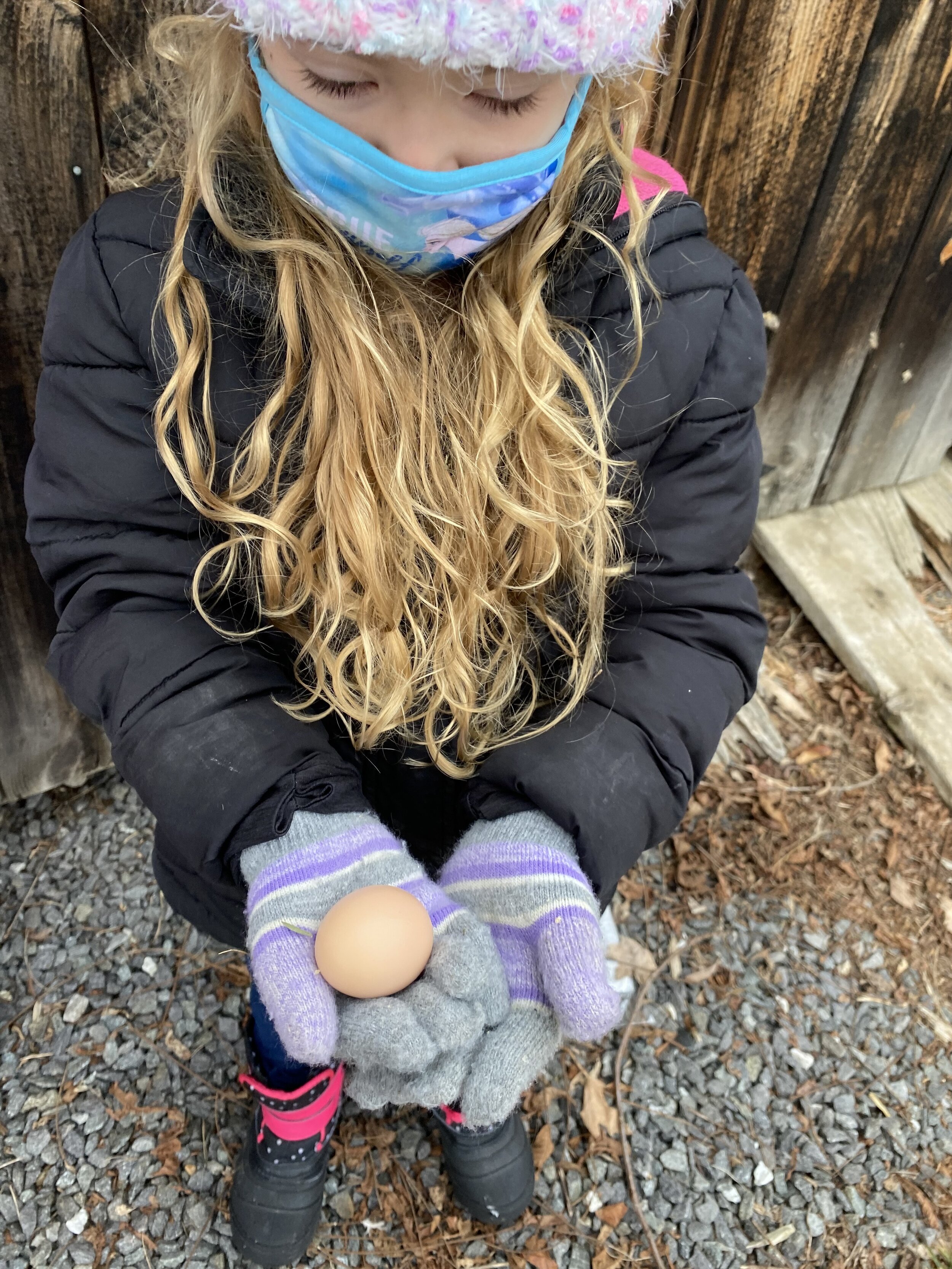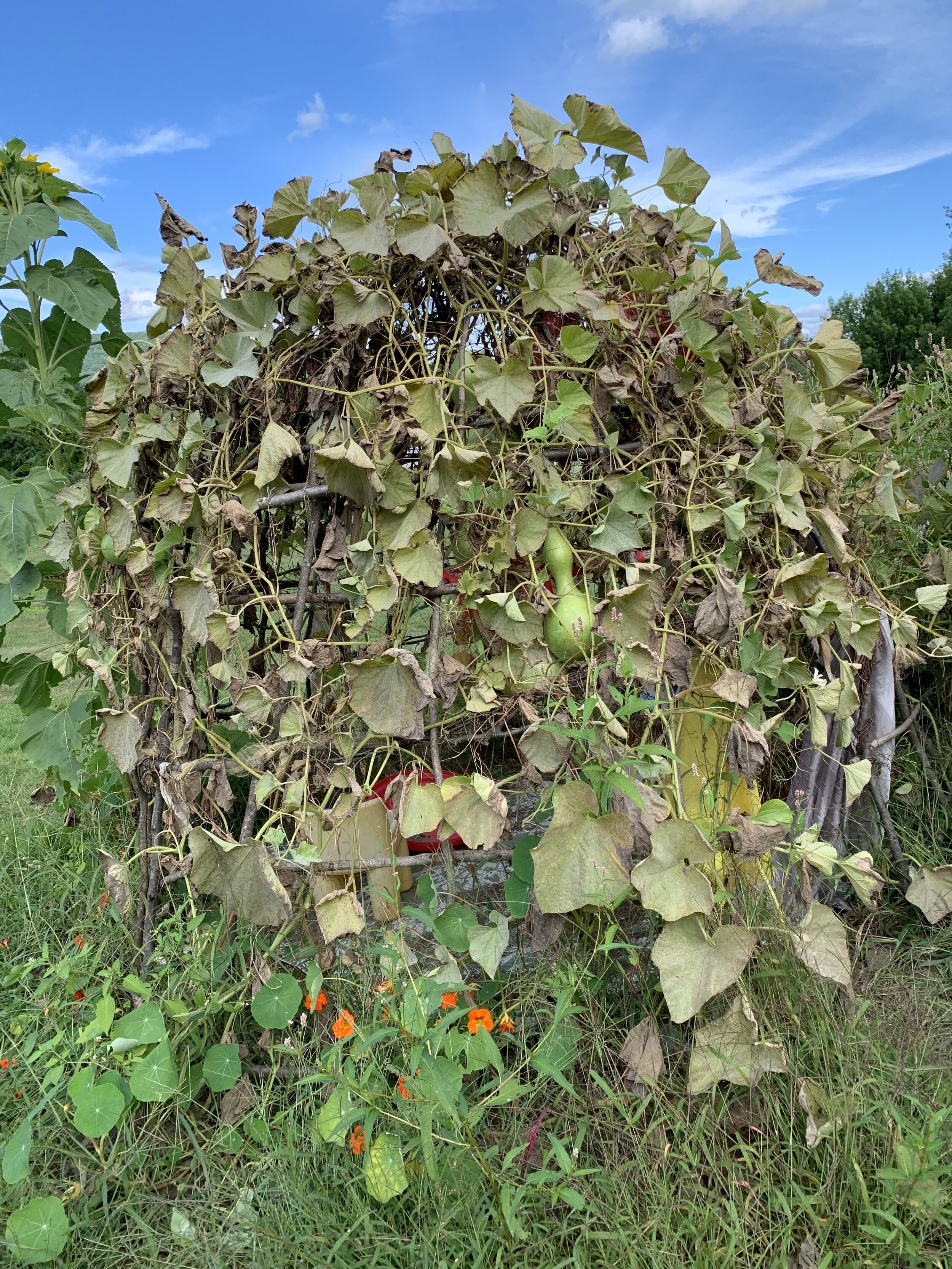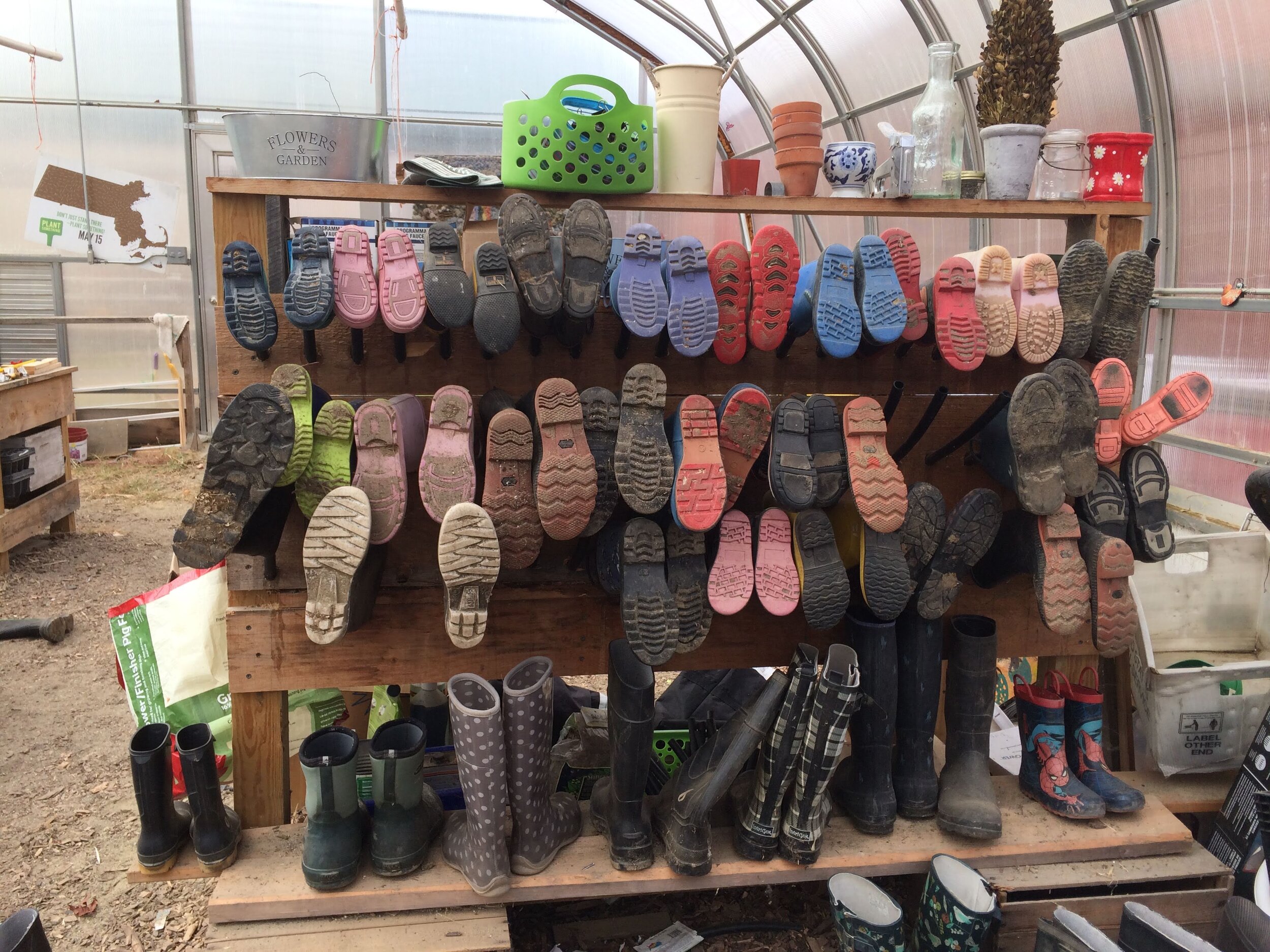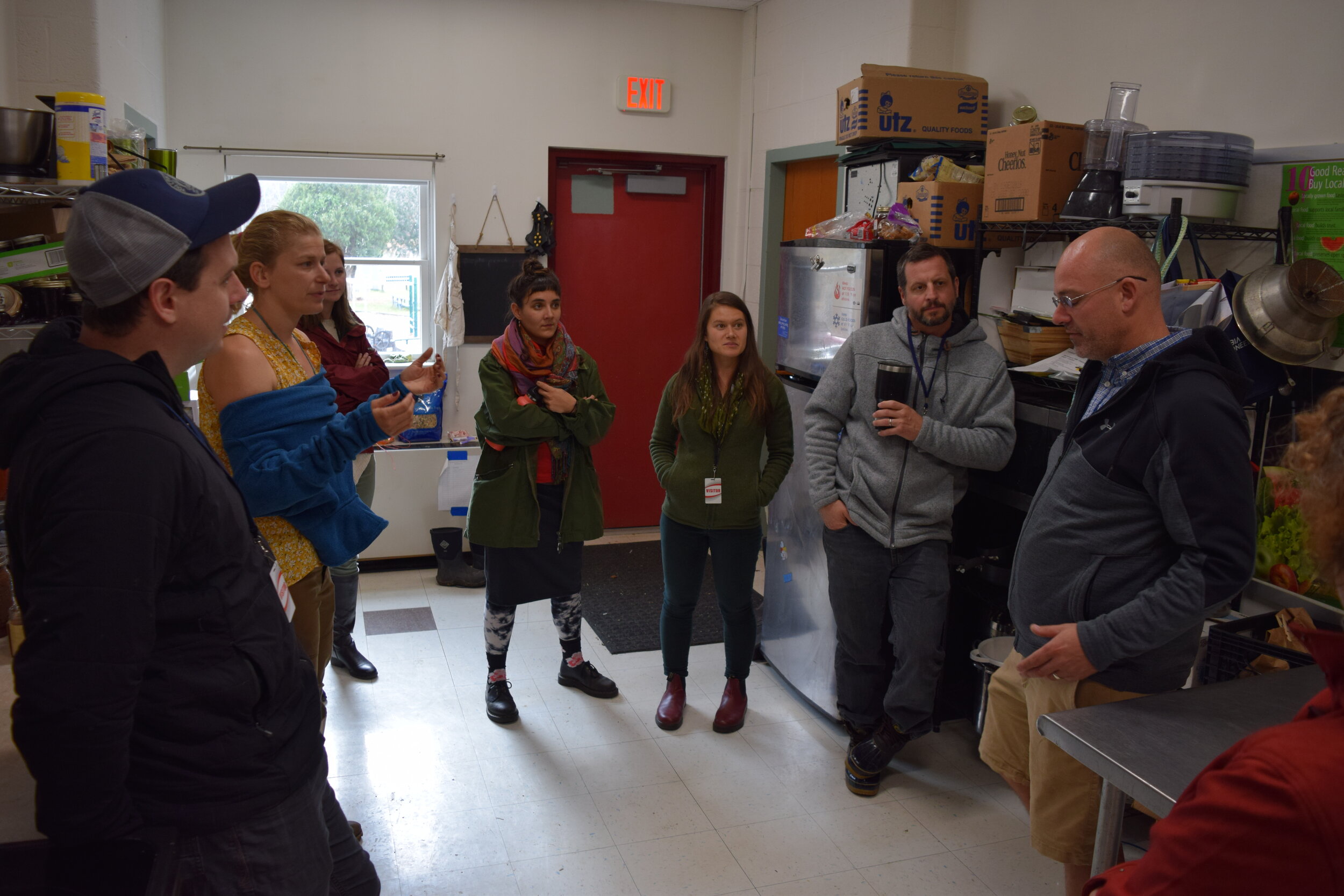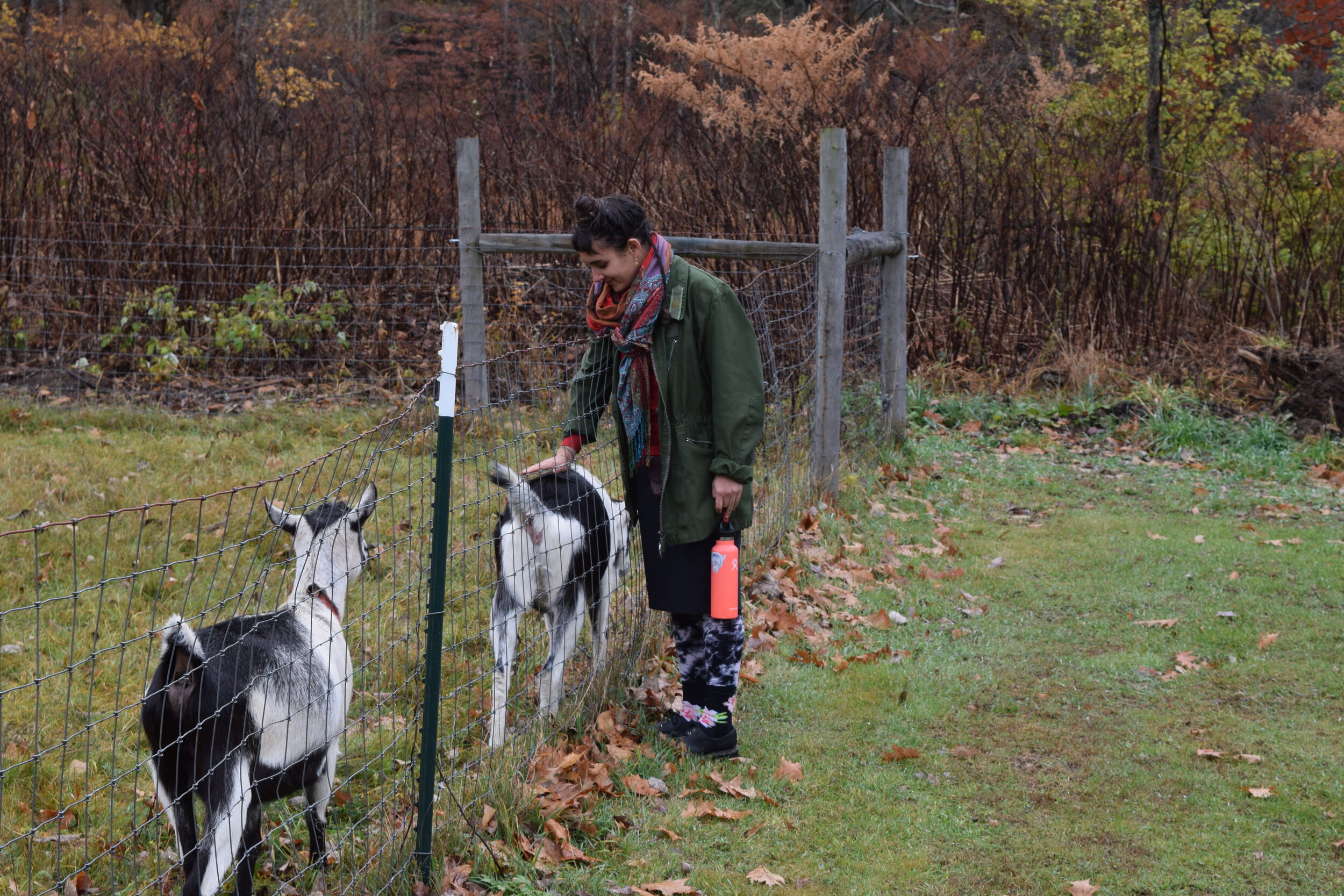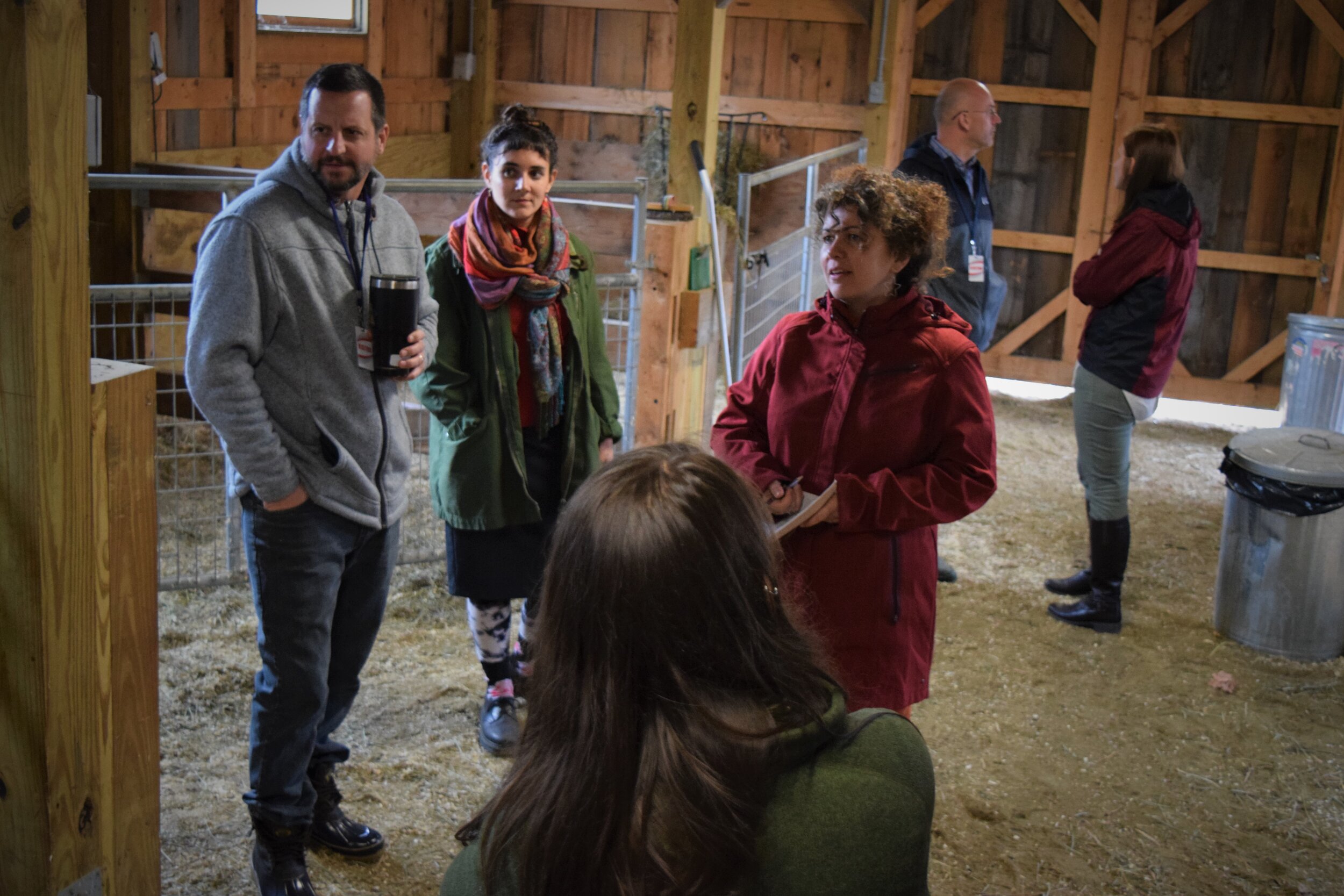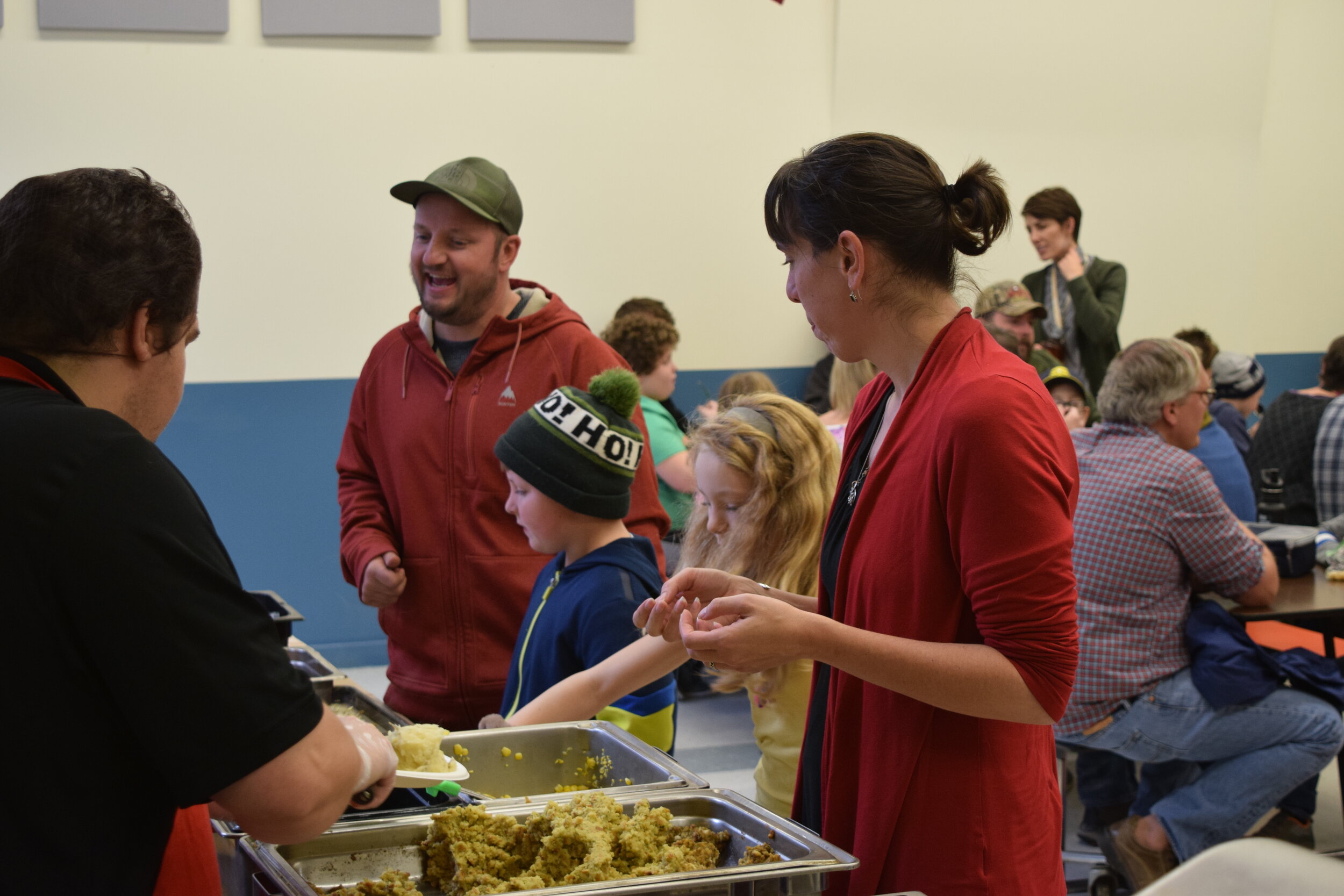The week before the start of the 2022-23 school year, Food Connects hosted a Celebration of Farm to School for school administrative teams and food service directors. We are so proud of the work being done by Farm to School teams at our member schools in Windham Central Supervisory Union, Windham Northeast Supervisory Union, and Windham Southeast School District, and we are grateful to the leaders who help make the work possible. At the event, we shared highlights from the 2021-22 school year at each member school, and we want to take a moment to share those highlights with a wider audience. Read on to hear the wonderful things happening in schools throughout the region!
Westminster Center School Celebrates Farm and Field Day
Stuffing scarecrows, painting pumpkins, cooking lunch over hot coals, and playing musical chairs… These are not your everyday school activities. But this is how the students at Westminster Center School spent the morning of October 29, when they celebrated their first Farm and Field Day.
Students from grades K-6 took part in six different activities crafted to link students to the outdoors and celebrate the harvest season. In addition to the excitement of scarecrows, pumpkins, and musical chairs (renamed “Boo-tiful Music!” in honor of the holiday), students went on a story walk, harvested kale from the garden for lunch, watched working farm equipment in action, and watched as the chicken for their kale salad cooked over coals in the outdoor cinder block kitchen, the “Cinder Cafe,” built especially for this event.
Despite the frigid temperatures, students were excited to be outside. “The best part is you get to have fresh air!” remarked Scarlett, a second-grader. “I’m having fun! It’s very fun!” exclaimed first-grader Anthony Lakeside. And fourth-grader Jenny said her favorite activity of the day was harvesting kale. “You get to peel all the leaves off!”
The librarian and Garden Coordinator, Mandy Walsh, said she was inspired by a similar event at Newbrook Elementary several years ago. Mandy has been growing the Farm to School program at Westminster for years and was excited to host her first Farm and Field Day. “We are so lucky to have the resources of gardens, animals, woods, and fields, and we live in a historically agricultural community. The day was about celebrating what's around us, coming together as a school community, and being joyful.” In reflecting on the success of the event, Mandy remarked, “I think that in the big picture, the best student learning happens when students get to be outside, working together, trying new things (food and activities). These are the days our students remember with fondness when they think back on their elementary school days.”
The Farm to School Team at Westminster is already planning future events and is flush with ideas of building on the tradition they’ve started. One thought was that perhaps next year, the sixth-graders could lead the stations rather than the teachers. Cheers to Westminster Center School for growing and cultivating leaders in the Farm to School Movement!
Cross-Pollination Gathering for School Garden Coordinators
Sarah Rosow searches for a cukamelon in the students snacking garden.
Garden Coordinators from five Windham County Farm to School programs gathered at Guilford Central School for a “Cross-Pollination” event in late October. Garden Coordinators, often somewhat isolated in their unique roles, had the opportunity to share ideas, challenges, and successes with each other as they prepare for winter activities in the classroom.
More and more area schools have hired Garden Coordinators in recent years, finding that they are a key component to a thriving Farm To School program. In addition to taking care of the gardens with support from students and volunteers, they also plan and execute educational activities around gardening and cooking and facilitate teacher and student involvement in FTS programming.
Sarah Rosow explains to Mandy Walsh how the Kelly Kettle works—a wonderful tool for making tea in the garden!
Sarah Rosow, Guilford’s Garden Coordinator since 2018, hosted the event, showing the visitors the school’s three different garden areas, the outdoor classrooms, and concluding with a “show and tell” of sorts where Coordinators discussed useful equipment for cooking outdoors, curriculum guides, and sample lessons. Everyone was inspired by Sarah’s “snacking garden” where students are able to snack freely on mint, cherry tomatoes, and adorable cukamelons growing on her archway.
As they toured the campus, Garden Coordinators discussed their roles at their schools and what makes their programs unique. While Guilford’s program excels at innovative outdoor teaching, Mandy Walsh of Westminster Center School offered the details of her upcoming Farm and Field Day—an event 3 years in the making, where students will participate in six different Farm to School stations. Kathy Cassin of Academy School spoke about her after-school cooking and gardening club while also gathering ideas about deterring the deer that had been eating all of Academy’s beautiful greens. After hearing that Mandy had some success with growing a border wall, she remarked, “that's good to know because it’s been so frustrating losing our greens!”
Sarah Rosow demonstrates using a pull chopper, which she uses to make fresh salsa and pesto in the garden.
Erica Frank of Central Elementary, a registered dietician and current Food Service Professional at the school, spoke about the value of getting kids involved in cooking. Amy Duffy, the new Garden Coordinator at Newbrook Elementary, agreed. “Giving kids a little more control over their eating then leads to better choices.” Amy also shared that she works with each grade once per week. Sarah Rosow responded, “I’d like to pick Amy's brain a little more in terms of the scope and sequence, and also just learning how she works in every grade level every week and how she manages that because I’d like to move toward that model.”
Everyone gained new ideas from this gathering, and it was clear at the end of the event that everyone had so much more expertise to share and so many more questions to discuss. In response, Food Connects looks forward to hosting more Cross-Pollination for Garden Coordinator events for our member schools throughout this school year.
Expanding Farm to School Throughout Windham County
Chroma Technology Supports Growth of Farm to School in the WNESU
Chroma Technology is growing Farm to School programs across the Windham Northeast Supervisory Union (WNESU) this school year by being the lead Farm to School donor for Food Connects, a Brattleboro-based non-profit serving schools in Windham County.
The Food Connects Farm to School program focuses on the “Three C’s” of Farm to School—classrooms, cafeterias, and communities. The generosity of Chroma Technology allows Food Connects to continue and strengthen its work in the WNESU. “We are incredibly grateful for the support that Chroma Technology is providing us this year,” says Sheila Humphreys, Food Connects Farm to School Coach. “Their dedication to Farm to School initiatives in our community ensures that more students can access locally grown food and can experience engaging Farm to School curriculum.”
“One of Chroma's core values is to be an active and caring member of our community,” says Newell Lessell, CEO of Chroma Technology. “Chroma supports Food Connects’s Farm to School program because helping develop healthy eating habits through education and access to nutritious, locally farmed food is good for children’s health, supports Vermont farmers, and builds healthy communities.”
So how do these funds impact schools and, more importantly, the students in the WNESU?
School Food
Bellows Falls Union High School students, and other students throughout the district, saw lots of local food throughout the summer through the Farm to School Cafe’s summer meal box initiative. This program provided students and their families with fresh, nutritious food throughout the summer, regardless of their financial circumstances. As part of Vermont Act 67 and the local food purchasing incentive, students will begin to see more local food on their trays this school year. The Food Connects Farm to School team is working hard to help school nutrition programs navigate this new incentive, in conjunction with offering Vermont grown and made foods through its Food Hub.
School Gardens
School gardens are an essential tool for hands-on and outdoor learning. Westminster Center School is a shining example of how school gardens can be done right. In May, the entire school participated in their Garden Day—a day where students plant seeds and seedlings in the school garden. As students harvest the final fruits of their labor, the garden continues to see an increase in infrastructure. Most notably, a frost-proof water spigot, a chicken coop, a small outdoor prep station, fire pits for outdoor cooking this winter, and blueberry bushes. Food Connects provided the school grant support, marketing materials, and hands-on support in the garden—and looks forward to supporting future garden projects, including the annual Farm and Field day later this month.
Farm to School Teams
Food Connects works with Farm to School teams throughout the region. This task is essential to help develop, guide, and implement Farm to School action plans, provide curriculum and grants support, and create materials and marketing for these programs. Central Elementary School formed a new Farm to School team this year that is participating in the Northeast Farm to School Institute. This school year, the school plans to expand its gardening and do more hands-on cooking in the classrooms, including monthly taste tests organized by the 2nd grade. Food Connects looks forward to working with Central’s Farm to School team to help bring in best practices for gardening and cooking with kids.
Grafton Elementary School is also deepening its Farm to School programming this year, with plans to add new grow labs, a hydroponic fish tank, and cooking tools, including a new oven to make it easier to teach cooking to students. Food Connects will continue to support these new initiatives through coaching and curriculum resources.
Planting Day Returns to Westminster
Take your pinky and thumb and spread them apart; press them into the soil, marking two holes. Now drop a sunflower seed in each hole and lightly cover it with soil. Westminster Center School’s Kindergarten classes continued the thirty-year tradition with seeds saved from the previous year’s sunflowers during a cloudy yet deceptively warm Planting Day this past May.
Returning after a hiatus last year due to COVID-19, Planting Day is a school-wide event to get the school gardens ready for the growing season. Every class in the school came out to work with Mandy Walsh, the school’s librarian and Farm to School teacher. Joined by Conor and Laura from Food Connects, Mandy led each class on a tour of the gardens before diving into their project for the day.
Fourth grade learned how any potato could become a “seed potato” and then planted the “eyes” in four mounded rows. Sixth grade was responsible for planting the corn, and then they got to work watering the rest of the garden, fed the chickens, and looked for snakes in the tall grass. Each grade had a specific crop that needed planting and saw how their efforts contributed to the garden’s success.
Throughout the day, the garden transformed from a tilled patch of soil to rows filled with plants. When students return in the fall, the crops will be ready for harvest. Students will work together to create a Harvest Supper to share with the community and celebrate their collective work.
Farm to School Educator Spotlight: Mandy Walsh
We’re approaching one year of COVID learning, remote schooling, hybrid classrooms, and way too many Zoom meetings, and luckily there’s still some fantastic Farm to School (FTS) education happening throughout our region. This month, we’d like to highlight Mandy Walsh, the Westminster Center School and Grafton Elementary School Librarian and FTS Coordinator! She’s been up to quite a lot this year, despite all of the added hurdles. Here’s just a taste:
Diving Deeper into Food Sovereignty
Given the new pod structure, Mandy is spending more time with classes. While this makes some of the whole school activities she used to do more complicated (such as taste tests), it allows her to dive deeper into specific subjects. She is working with all grade levels on studying food access, food justice, and more intentionally investigating their local food system. The Groundswell Center for Local Food and Farming is a go-to resource for herself as she learns more about these issues. Her lessons range from Temple Grandin (an American scientist and advocate for the humane treatment of livestock) to the effects of global warming through literature (check out Sea Bear by Lindsay Moore) and thinking about human rights by reading the UN’s Universal Declaration of Human Rights.
Outdoor Education
This year, a trend we’ve seen across the region is a turn to outdoor education, and Westminster and Grafton are no different. Not only are students getting outside more, but they’re building fires and cooking as well. A popular recipe is bread on a stick. We’re hoping that outdoor education will stick in schools, even post-pandemic.
Chicken Coop
After being inspired by a trip to the Hawlemont School in Western Massachusetts, Westminster decided to retrofit an existing garden shed into a chicken coop. The project started as a community collaboration. Buck Adams Trucking & Excavating volunteered their time to clear the space by the shed, a neighbor donated fertilized eggs to start the flock, and Mandy’s husband came in to build the chicken yard enclosure.
Adam, the Maintenance Director, has been a big part of the FTS team as they’ve added garden space, blueberry bushes, and now the flock of chickens. Staff members also chip in to care for the chickens, especially on weekends and school breaks, when coordinating chores becomes more difficult. Each class gets to visit the chickens once a week. The flock has truly become part of the school community!
The FTS team hopes to grow the flock until they can begin regularly supplying the school kitchen with fresh eggs.
Are you a teacher in Windham or Windsor counties? We’d love to hear about your FTS successes this year! Shoot us a message at farmtoschool@foodconnects.org.
What’s Been Cooking in 2020
Who would have guessed 2020 would end with sweet potatoes roasting over an open fire?
Cooking and nutrition education are bright spots for schools across the region as teachers adapt and evolve to a constantly changing situation—truly embodying resiliency (a contender for 2020 Word of the Year). This story of resilience stands as a testament to the fundamental role Farm to School programming plays in today’s general curriculum—cooking kept students hands-on during remote learning and has flourished during the return to (increasingly outdoor) classrooms.
Westminster Grow Pack.
Last spring, schools closed swiftly—winter boots left in cubbies and desks full of supplies. Teachers had difficulties getting into their classrooms to grab materials for their lessons. Despite these challenges, cooking and gardening education continued to enliven the curriculum. Sarah Rosow (Guilford Central School) and Mandy Walsh (Westminster Center School) got grow kits out to students via pick up locations and bus deliveries. These kits enabled students to get their hands dirty in the “garden”, even if they lived in an apartment. At Riverside Middle School, STEAM teacher Becca Osbourne tried her hand at virtual cooking lessons, which her 6th graders particularly took to.
A crucial part of cooking education takes place long before students begin chopping veggies. Farm to School programming focuses on cycles—for food, the cycle is most powerful when students have a hand in each part of the process, from seed to plate (or Seed2Tray when talking about food in the West River Education District). Recognizing this, school garden coordinators worked hard last spring to ensure gardens were planted—filled with intentions of a bountiful fall and a return to normalcy.
River Gallery Arts visits Oak Grove School.
Food Connects hosted regional calls for coordinators to share tips and tricks and provide connection during an otherwise distanced season. Thanks to these collective efforts, gardens thrived this past summer. Food Connects Garden Coordinator, Tara Gordon, maintained six of the gardens in Windham Southeast Supervisory Union and we piloted free family art activities thanks to support from RiseVT and three local arts organizations—River Gallery School of Art, Insight Photography, and the Human Art of Play. The culmination of these regional efforts were gardens readily awaiting the return of students if public safety would allow.
Gardening at Winston Prouty.
Food Connects helped new cooking programs get started this school year. The Early Learning Center at Winston Prouty attended the New England Farm to School Institute this past summer with Food Connects FTS Coordinator, Sheila Humphreys, as their coach. With an established school garden, the team has laid a foundation for the next level of Farm to School work, including incorporating local foods onto their menu, Harvest of the Month Taste tests, and building a strong committee to carry the work forward. Through a RiseVT grant received by Food Connects, the team purchased materials for a cooking cart. Not only does the team intend to do more cooking with students, but they’re excited to start processing school-grown produce into homemade baby food and snacks.
A staggered reopening of schools this fall came with its own set of challenges. What we’ve seen from our member schools is that those that leaned the furthest into outdoor education have seen the most success—ie. engaged students, happy teachers, and creative lessons. Food Connects helped schools keep cooking on the menu through specific guidance; stepping into an otherwise empty space, our Cooking with Students during COVID-19 guidelines provided a framework for educators and administrators to confidently establish safe practices around their cooking lessons. And we’ve seen those cooking lessons flourish—whether it be pumpkin pancakes in Guilford, pizzas at Green Street, or fire-roasted sweet potatoes at Academy.
Cooking with students at Academy School.
At Academy School, garden coordinator Kathy Cassin took advantage of a warm fall and large school forest to cook with students. Not only did students cook roasted sweet potatoes in November but Kathy also prepared sweet potato cookies and hummus for students to try. Students at Academy School can expect to see even more outdoor cooking in 2021 thanks to the addition of multiple fire rings purchased through grant funding Food Connects helped secure. These new fire rings will enable more students to be cooking at the same time while also making it safer for students.
Not only has cooking and nutrition education found a way to continue throughout 2020—but the garden and outdoor kitchen (firepit) have become some of the most popular places to be at school. Most importantly, the sounds of growing taste buds have returned—“I don’t usually like soup, but this is pretty good.”
Back to School During COVID-19
Leaves are starting to change and there’s a hint of fall in the air, and during this most unusual year, students are learning and growing in schools and homes throughout Windham County. One of the benefits of working as a Farm to School team coach is that we get to experience the many diverse colors and flavors of back to school throughout the region. Here are a few from schools and districts across the region.
At schools throughout the Windham Southeast School District (WSESD), teachers and students are spending more time than ever in school gardens as they learn to maximize their time outside and use school gardens as outdoor learning spaces.
At Academy School, plans are being made to add a new pumpkin patch where students can grow pumpkins for the school’s annual pumpkin festival. Teachers are working together to see what’s possible in terms of building an onsite composting system as part of hands-on science for 6th grade, and Academy welcomes back Kathy Cassin for her second year in the role of Garden Coordinator. The gardens are looking great, and Food Connects’ summer garden coordinator Tara Gordon froze basil for fall cooking projects with students. The school is hoping to find funding this year to buy 2 or 3 mobile cooking carts to enable them to cook more with students.
Oak Grove School’s garden is bountiful this year with watermelons, tomatoes, acorn squash, Aronia berries, and kale. Normally the school community gathers together each October to celebrate the harvest with a community meal made by students using produce grown in the garden. Instead, this year teachers are getting creative and finding ways for students to enjoy the harvest during their in-person learning days throughout the fall. The first farm to school meeting of the year included conversations about the best recipes for kale chips and what to do with dehydrated tomatoes. Students will make signs for the garden to identify the variety of foods they’ve grown, and thanks to a grant from Blue Cross Blue Shield, garden coordinator Tara Gordon and pre-K teacher Jamie Champney plan to buy more kitchen equipment for the school’s cooking cart.
At Guilford Central School, Sarah Rosow, the Farm to School Coordinator, continues to work with students in the garden. She hopes to grow the garden and replace aging infrastructure—a grant was submitted for new raised beds and more supplies. The Guilford community is busy supporting the school by expanding the outdoor learning spaces. They are constructing two beautiful pole barns and work on their forest classrooms continues.
Twin Valley Elementary School is wrapping up a School to Farm project with NOFA-VT in which they built connections with Boyd Family Farm in Wilmington. The project was interrupted this spring by COVID-19 and will continue this fall with farm-fresh taste tests for students and a virtual tour of the farm filmed by NOFA staff to share with the school community.
The newly formed Farm to School Team at Winston Prouty’s Early Learning Center is excited to use produce from their garden to make homemade baby food this fall to feed to their youngest students. The first recipes use mashed squash from their plentiful butternut squash crop. The students thoroughly enjoyed playing in the gourd house throughout the summer, which became more and more magical as the gourds grew above their heads!
At Riverside Middle School the Farm to School team worked with students to collect pumpkins from the nearby church garden. The garden club will put Greenies Garden to bed this month and plan for next year. The last funds from a Vermont Agency of Agriculture, Food, and Markets (VAAFM) Nutrition Grant were used to buy two Jora brand composters for the school. Cliff Weyer, the Design and Technology teacher, is working with his Community Engineering class to assemble both units.
In the Windham Northeast Supervisory Union (WNESU), a new commercial veggie peeler at the high school kitchen means the food service team can process more local produce and include it in lunches! Harley Sterling, the School Nutrition Director, recently processed a large batch of potatoes from Westminster Center School’s (WCS) garden. WSC built a chicken coop over the summer and a flock of chickens has now officially moved in! Now, in addition to a bountiful garden, students can collect fresh eggs for classroom cooking projects and share them with the nutrition program, Farm to School Cafe.
At Newbrook Elementary School, the community harvested potatoes, squash, corn, and herbs from the garden. Some of the produce will go right into the school nutrition program while others will be saved for activities with students throughout the year. Teachers are getting ready for students to return to the classroom and thoughts have turned to the annual Farm and Field Day celebration. While it won’t look the same as in years past, there’s still hope that an adapted version can be held for the students to celebrate their school community.
Lessons Learned from Two Food Connects Learning Journeys
This past summer, Food Connects accompanied two Farm to School teams to the Northeast Farm to School Institute (NEFTSI) summer retreat. The retreat kicked off a year-long program where teams receive Farm to School program support and professional development as well as year-round coaching. Academy School from WSESD and a joint Grafton Elementary School and Westminster Center School team from WNESU spent three days at Shelburne Farms planning for the school year, learning more about Farm to School programming, and networking with other professionals from across New England and New York.
As the rush of back to school started to slow down, Food Connects Farm to School coaches, Conor and Sheila, reconnected with their NEFTSI teams, excited to kick off the new school year with a strong Farm to School focus. Still energized by the summer retreat, both teams wanted to make sure they stayed connected with the larger Farm to School community while also working to improve the programs in their own schools. Luckily for everyone, southeastern Vermont and western Massachusetts are home to a number of leaders in the Farm to School movement. At Sheila’s suggestion, Food Connects helped to coordinate personalized learning journeys for both teams to visit two robust Farm to School programs in the area.
Hawlemont Regional School
Hawlemont is a public pre-K through 6th-grade school in the rural community of Charlemont, MA. Hawlemont was struggling to stay open after school choice resulted in declining enrollment. In an effort to save the school, staff and local community members decided to reinvent the school with a “farm-flavored approach to learning.” The HAY (Hawlemont, Agriculture, and YOU) program is now in its fifth year, and during that time the school has doubled its enrollment and now has a waiting list.
Hawlemont received grant funding and leveraged community support to build their program, using grant funds and donated supplies and labor to build a greenhouse, barn, and garden beds, and teachers worked together to create an integrated farm and food curriculum. The result is a complete reimagining of the school, featuring successful collaborations with local farmers and community members where Hawlemont students engage in hands-on learning as they care for animals, nurture gardens, and develop new skills in a real farm setting.
Hawlemont added a new staff position, HAY teacher, and all students have HAY class each week for 30-45 minutes, just like music, art, and PE classes. Each class has daily barn chores and learns cooking, canning, and preserving, as well as beekeeping and running a weekly in-school farmers market where produce from the school garden and value-added products like pesto, canned tomatoes, salsa, jelly, and freshly baked pies all made by students are sold to parents and the community.
Hawlemont is working hard to get more local food into its independently run lunch program. In addition to purchasing from local farms, when budgetary constraints allow, all of the jelly used for PB & J’s for the entire school year comes from jelly students in the HAY program make from either grapes grown on the school property or from fruit picked by students from local farms.
Guilford Central School
For years, Guilford has worked hard at building its Farm to School program and they have been a partner of Food Connects since 2014. In her second year, Sarah Rosow is the school’s Farm to School Coordinator. As both teams saw during their visits, Farm to School programming is strongest when there is a consistent collaboration between a dedicated coordinator and a team of champions from throughout the school. At Guilford, Sarah works with all the teachers to find time to incorporate Farm to School lessons into their existing curriculum as well as additional enrichment activities. She works with Dan, the school’s food service director, to integrate taste tests and Harvest of the Month items into the menu. Through this collaboration, Sarah is able to stay focused on Farm to School and keep projects moving forward, while the team of faculty and staff ensure that there remains a strong culture of Farm to School throughout the building.
So what does Farm to School at Guilford look like for the students? Getting dirty in the gardens, cooking up delicious Harvest of the Month recipes in the Farm to School room, and working in their classrooms to design and make market-ready products for the school gardens. From pre-K all the way to the 6th grade, students engage in Farm to School through classroom learning and extension activities.
Farm to School also reaches the cafeteria, where Chef Dan is an active member on the Farm to School team and works with Food Connects to increase local purchasing and track trends over time. This past Thanksgiving, Dan put on a feast for the entire community that highlighted many local items. Now, he’s working with Sarah to highlight many of the dishes students make in the Farm to School classroom by incorporating them into his lunch menus.
The Guilford Farm to School program made a particularly large splash this past month when they hosted their inaugural Holiday Market, where local vendors joined students in selling different crafts. Of the money made by each classroom by selling their items, half is being donated to a charity of their choosing and the other half is going to be reinvested in Farm to School programming for the students.
After two inspiring days of learning and sharing, there were definitely some themes the teams walked away with when thinking about program longevity and sustainability. In both schools, there was a balance between team collaboration and a main coordinator. Oftentimes, Farm to School programs grow their roots in a school thanks to the devoted efforts of a single champion. While that helps keep the momentum going, it’s important to quickly build a diverse team of support. Otherwise, when that champion leaves or becomes too busy themselves, all the work they did can get lost in the shuffle.
The community support both schools have is also one of their greatest strengths. In Hawlemont, community members rallied to save their school, build a barn, and help care for the animals. Guilford partners with local farmers to source beef for lunches, handle their food scraps, and support events like the Holiday Market. In addition to gathering a diverse team of school staff, another first step for a fledgling Farm to School program should be to think about what makes their community special and ways to involve community members as much as possible.
Lastly, both programs are actively involved in parenting their financial sustainability. Grants and fundraising are inevitably a big part of Farm to School. Having dedicated coordinators to work on larger projects and support from organizations like Food Connects goes a long way in supplementing school budgets. Each program has its own needs, but having a variety of funding sources for staff and materials is key in creating robust programs that carry on for years.
Cafeterias Unknown: Thanksgiving Extravaganza
November is a time when Farm to School comes alive in the cafeteria. As the Vermont growing season comes to an end and excitement grows for Thanksgiving break, school nutrition staff across the state are hard at work preparing feasts for hundreds. Turkey, mashed potatoes, stuffing, gravy, and roasted veggies fill students’ trays as each school celebrates the holiday in their own unique way. I was able to visit a few schools, lend a hand in the preparations, and enjoy some delicious food. Did I mention, Thanksgiving is also my favorite meal of the year?
Guilford
Chef Dan serving up stuffing and mashed potatoes.
Guilford Central School hosts a Thanksgiving lunch for staff, students, and parents and this year over half the dishes being served were local—the turkey, sweet potatoes, mashed potatoes, and apple crisp to be exact. Pulling into the parking lot, it was clear that word of the menu had gotten out and I ended up having to park on the street!
After trekking across the parking lot, I made my way through packed hallways to find Chef Dan in the kitchen. Kindergarten through third grade had just finished up and he was getting ready for the second wave of hungry customers. I washed my hands, put on some gloves, and jumped in the buffet line. The staff volunteers and I served up heaping plates of food to grateful students and their teachers and parents until the tables were packed full.
After the rush, it was time for me to load up a plate for myself and revel in the delicious food. The sweet potatoes in particular were a highlight—perfectly cooked and accompanied by a medley of spices that brought the dish to another level. Kudos to Chef Dan for pulling off an amazing meal, I’ll definitely be back next year!
Full house in the Guilford Central School cafeteria during their Thanksgiving lunch.
Westminster
At Westminster, their community meal diverts from the traditional Thanksgiving dishes, and instead keeps the spotlight on local. I arrived the day before to see what work went into hosting the community. Student ownership is what it’s all about at WCS and at around 1pm, the whole school gathered in the gym to break into their respective “longboats” (the school mascot is a Viking). From there, students set off on their tasks. Some groups were prepping the silverware, while others were decorating the rows of tables laid out in the gym. I followed a large group to the cafeteria, where 40 students equipped with peelers, knives, and cutting boards would be prepping produce for the meal.
Students washed, peeled, and chopped the produce themselves (with adult supervision!)
Local carrots and potatoes and onions grown in the school garden before being prepped by the students.
With food from the school garden and local farms spread across the tables, students in the cafeteria broke up into stations. Three groups peeled and washed potatoes, others chopped carrots, while the last two groups were tasked with dicing onions—four quarts of diced onions later, there was a fair share of onion-induced tears. To say the cafeteria was calm would be a lie, but a teacher-led each group of students and modeled safe knife skills. The whole room remained in a state of controlled chaos while students engaged in real work and helped the school’s nutrition staff prepare for the upcoming feast.
At the end of the hour, everyone was able to admire their handiwork. Cheese plates ready for eating and the veggies prepared for Melissa—WSC’s site nutrition manager—to transform into delicious chowder. The following day, students would be able to invite their families and friends into the school to share a meal they truly had a part in creating.
Cheese plates arranged for the next day’s big event.
Does your school have a community feast, holiday meal, or local day that you’d like to celebrate? I’d love to highlight your traditions in our newsletter—email me at conor@foodconnects.org!
By Conor Floyd














